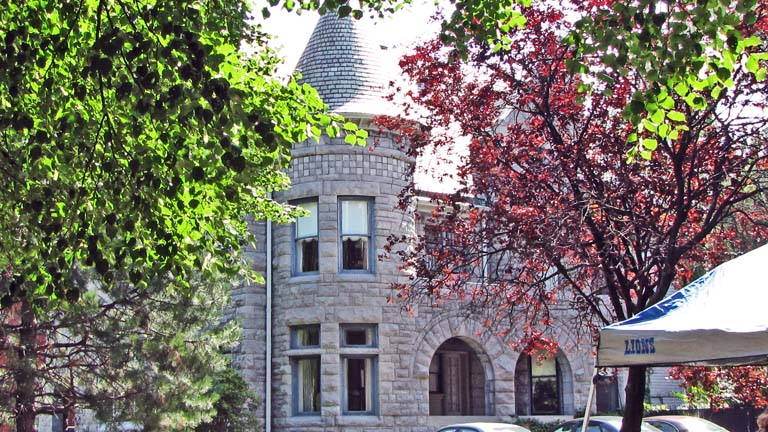

William A. Pungs was born in Cologne, Germany on April 25, 1849. About two years later, his family migrated to Detroit. At that time, Germany and Ireland were the leading origins of international immigrants. Pungs attended the city’s schools and then went to work in businesses that supplied carriage makers, the railroads and machinery makers. In 1882, he organized the Michigan Railway Supply Company. This became a very prosperous firm and provided him with the resources he needed to commission Malcolmson and Higginbotham to design the attractive rock faced home that you see pictured here. You will note that it differs in style and color from the Victorian and Queen Anne style homes that grace the east side of East Ferry Street between Woodward and John R.
Once he had wealth, William Pungs invested in many Detroit area manufacturing firms. In doing so, he was linked to the development of the automobile industry in Detroit. In 1895, he joined with several other investors to bring the successful Anderson Carriage manufacturing firm to Detroit from its former home in Port Huron. Later, this business became the Pungs-Anderson Carriage Company and began producing bodies for motor vehicles. The firm’s successor became the producer of Detroit Electrics—the most successful electric car manufactured in Detroit, at least until the time Chevrolet began assembling Chevy Volts.
Pungs had also invested in the Michigan Yacht and Power Company—a firm that produced boats powered by gasoline engines. That firm purchased the Sintz Gas Engine Company of Grand Rapids and moved it to a plant in Detroit at the intersection of Baldwin and East Jefferson where a hospital linked to the new medical school of Oakland University now stands. The Stintz firm has assembled a gasoline powered automobile in Grand Rapids as early as 1892.
William Pungs’ son-in-law, E. B. Finch, graduated from the engineering program at the University of Michigan. Finch recognized opportunities in the vehicle industry and wished to produce cars, but lacked capital. His father-in-law could and did supply that.
By 1903, Finch produced his first vehicle. I believe the car was assembled at the East Jefferson plant, presumably using the talents of those who manufactured gasoline powered yachts.
I believe their first production model was a small 1904 car with a 14 horsepower engine. Apparently, 150 of those cars were built and sold but none may have survived to the present. Those sales led to the formation of the Pungs-Finch Automobile and Gas Engine Company. By late 1905, the firm was selling a “Finch Limited” model. This was a large and expensive car with a 55 horsepower engine—one of the larger engines to be found on a production model in that era. In recent years, Chrysler has proclaimed the virtues of their powerful “Hemi” engines. The 1905 Finch was, presumably, the first auto engine to use a hemispherical combustion chamber for its four cylinders. To demonstrate the capability and reliability of their model, Finch and a colleague drove from Detroit to New York in October, 1905. They completed the 880-mile journey in 48 hours with no breakdowns, thereby setting a long distance speed record. Again in 1906, the firm introduced new and much larger cars selling for very hefty prices. You wonder how their public relations staff and sales agents tried to popularize the less than euphonic Pungs-Finch name.
At some point Pungs and Finch had a falling out. Finch left the firm and become an engineer for the Packard Motor Car Company and then went on to become a Chalmers dealer in Cleveland. The Pungs-Finch factory on East Jefferson, I believe, burned in 1908. The firm did not survive the loss of Finch and the factory. It was out of business by 1910. William A. Pungs lived until 1941. So far as I know, he did not get back into manufacturing cars. I do not know how long he lived in the home that you see.
After the death of Charles Lang Freer, his home—across East Ferry from the Pungs residence—became the home of the Merrill-Palmer Institute, a small college that trained teachers. In 1934, that Institute began using the Pungs home as a dormitory.
In the late Twentieth Century, the maintenance of homes on the east side of East Ferry declined. The Detroit Institute of Art announced plans to turn the area into a parking lot, but that never occurred. This home, and three others in this block, have recently been restored to their original grandeur to serve as the Inn on Ferry Street.
Date of construction: 1891
Architects: William Malcolmson and William Higginbotham
Architectural Style: Romanesque Revival
Use in 2012: The Inn on East Ferry Street
Website: www.theinnonferrystreet.com
City of Detroit Designated Historic District: This home is within the East Ferry Street District; Listed July 17, 1981
State of Michigan Registry of Historic Places:
East Ferry Street Historic District; listed February 14, 1976
National Register of Historic Sites: East Ferry Street Historic District; #80001921; Listed March 10, 1980,
Photograph: Ren Farley; July 25, 2012
Return to Historic Residences
Return to Homepage